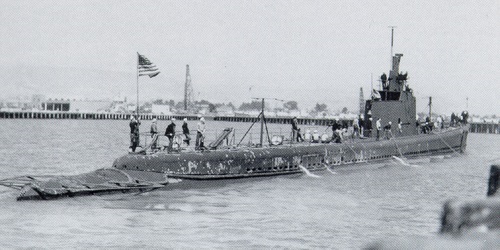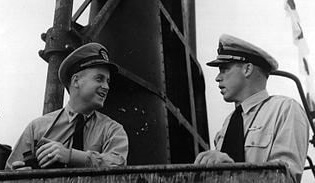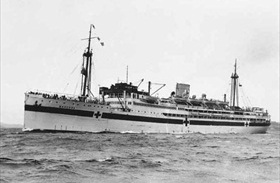U-BOAT SHOOTS SHIPWRECK SURVIVORS
U-852 in Mid-Atlantic Ocean · March 13, 1944
On this date in 1944 German U‑boat 852, skippered by 28‑year‑old Heinz-Wilhelm Eck, torpedoed the British-chartered Greek freighter SS Peleus as it steamed west across the Atlantic from Freetown, Sierra Leone, to Buenos Aires, Argentina. After the Peleus sank, U‑852 patrolled the large debris field for five hours. Crew members used hand grenades and automatic weapons to shoot survivors and destroy evidence of the Peleus’s demise. Of the 35 men aboard the Greek vessel, including eight British seamen, three sailors managed to survive.
Less than a month later, on May 2, Eck himself survived the loss of his submarine when six British bombers forced it onto a reef off the Somali coast. After the war, Eck was tried, convicted, and condemned to death, along with his engineering officer and the ship’s doctor, by a British military court in Hamburg for ordering his crew to shoot the survivors of the Greek steamer. (The Hague Convention of 1907 banned the killing of shipwreck survivors under any circumstances.) The three Germans were the only submariners executed for war crimes committed during World War II.
An event similar to the fate that befell the Peleus survivors besmirched the reputation of Dudley “Mush” Morton, the U.S. Navy’s most famous submarine skipper. On January 26, 1943, the USS Wahoo torpedoed a Japanese transport ship, the Buyo Maru, north of New Guinea. Surfacing, crew members of the Wahoo used their 4‑in (102mm) deck gun, two 20mm guns, rifles, and pistols to fire on survivors, some floating in the ocean, some in roughly 20 lifeboats. Morton’s executive officer, Richard O’Kane, claimed that the survivors opened fire first and the crew responded with everything they had for the next 20 minutes instead of leaving the area and consigning the estimated 600‑plus Japanese troops and nearly 500 Indian prisoners of war to a watery grave. According to one account used to explain Morton’s behavior, the skipper was enraged by stories of Japanese planes strafing survivors of an Australian hospital ship, the AHS Manunda, damaged during their attack on Darwin’s harbor in February 1942. “The Japs fight hard and use all the tricks,” Morton reportedly said, “and we’ve got to shoot, shoot, shoot.”
[amazon_carousel widget_type=”ASINList” width=”600″ height=”200″ title=”Recommended Reading” market_place=”US” shuffle_products=”False” show_border=”False” asin=”1603440836,0813141109,0891415726,1591145325,0451238109,1574887343,047119705X,0451232321,155750217X,047138495X” /]
USS Wahoo and Submarine Skipper Dudley “Mush” Morton.
His Watchword Was “Shoot the Sunza Bitches”
 |
Above: USS Wahoo, sunk October 11, 1943, by Japanese ships and aircraft in the strait that separates the Russian island of Sakhalin and the Japanese island of Hokkaidō.
 |  |
Left: Skipper Dudley “Mush” Morton (right in photo) speaks with his executive officer, Richard O’Kane, on the bridge of the Wahoo days after sinking the Japanese troop transport Buyo Maru on January 26, 1943. During his four patrols commanding the Wahoo, Morton became one of the most-celebrated submariners of World War II, sinking at least 19 Japanese cargo and transport ships for a combined total of 55,000 tons, more than any other commander of the time.
![]()
Right: The newly fitted hospital ship AHS Manunda in Darling Harbor, Sydney, Australia, August 1940. The Manunda made four trips to the Middle East and the Mediterranean between November 1940 and September 1941. The hospital ship was one of 55 ships caught in the harbor during two Japanese air raids on Darwin, Northern Territory, on February 19, 1942. Despite her highly prominent Red Cross markings, the ship was damaged by a near miss, then a direct hit. Eleven members of the ship’s crew and hospital staff were killed, nineteen others were seriously wounded, and another forty or so received minor wounds. The hospital ship was able to deliver its wounded and other Darwin casualties to Freemantle, the port of Perth, Western Australia, eight days later. During the war she carried roughly 30,000 casualties to safety.
History Channel’s Submarine Warriors: Dudley “Mush” Morton and Richard O’Kane
![]()

 History buffs, there is good news! The Daily Chronicles of World War II is now available as an ebook for $4.99 on Amazon.com. Containing a year’s worth of dated entries from this website, the ebook brings the story of this tumultuous era to life in a compelling, authoritative, and succinct manner. Featuring inventive navigation aids, the ebook enables readers to instantly move forward or backward by month and date to different dated entries. Simple and elegant! Click
History buffs, there is good news! The Daily Chronicles of World War II is now available as an ebook for $4.99 on Amazon.com. Containing a year’s worth of dated entries from this website, the ebook brings the story of this tumultuous era to life in a compelling, authoritative, and succinct manner. Featuring inventive navigation aids, the ebook enables readers to instantly move forward or backward by month and date to different dated entries. Simple and elegant! Click 











